You’ve decided to embrace the convenience and effectiveness of a home exercise bike – that’s a brilliant first step!
Perhaps our Ultimate Beginner’s Guide to Choosing and Using an Exercise Bike at Home got you excited, or maybe you’ve already explored the Advantages of Cycling at Home for Beginners.
Now, you’re faced with a pivotal question – Upright, Recumbent, or Spin bike?
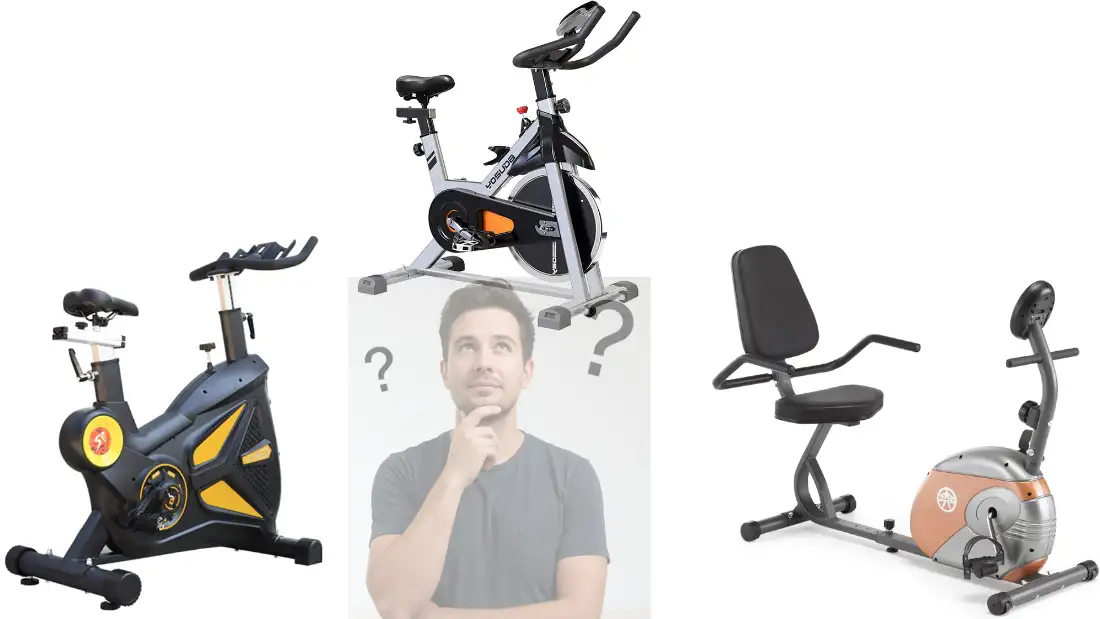
It feels like choosing your starter Pokémon – each has unique strengths, but which one will be your trusty companion on the road to fitness?
This isn’t just about picking a piece of equipment; it’s about finding the best exercise bike for beginners like you – one that feels good, meets your needs, and, crucially, you’ll actually want to use.
Let’s demystify these three popular options and guide you to your perfect pedaling partner.
Key Takeaways – Your Quick Guide to Bike Types
- Upright Bike: Think classic cycling. Good for general fitness, engages the core, and often more space-efficient.
- Recumbent Bike: The comfort king. Ideal for maximum joint and back support, making it super inviting for true beginners or those with physical limitations.
- Spin Bike (Indoor Cycle): For the aspiring athlete. Mimics a road bike, built for intensity and performance.
- The “Best” is Personal: Your ideal bike hinges on your comfort preferences, fitness goals, and current physical condition.
Before We Dive In – What Kind of “Beginner” Are You?
The term “beginner” is broad. Your personal starting point will heavily influence which bike type feels like the best fit.
Take a moment for a quick self-reflection:
- A. The “Just Starting Out” Beginner:
- You have little to no recent exercise experience.
- Your main goals are to build a basic fitness foundation, establish a consistent routine, and feel comfortable while doing it.
- Potential concerns might include joint discomfort, feeling intimidated by complex equipment, or simply lacking exercise confidence.
- B. The “Returning to Fitness” Beginner:
- You’ve been active in the past but have been on a break and feel deconditioned.
- You might have more specific goals like weight management or improving stamina.
- You’re looking for something engaging and sustainable to get back on track.
- C. The “Ambitious & Athletic” Beginner:
- You might be new to cycling specifically, but you’re generally active or have an athletic background.
- You’re drawn to higher intensity, performance metrics, and a more challenging workout experience from the get-go.
- Initial comfort might be less of a priority than the bike’s capability for challenging workouts.
Keep your “beginner profile” in mind as we explore each bike type. This self-awareness is your first step to choosing wisely.
The Upright Exercise Bike – The Familiar All-Rounder
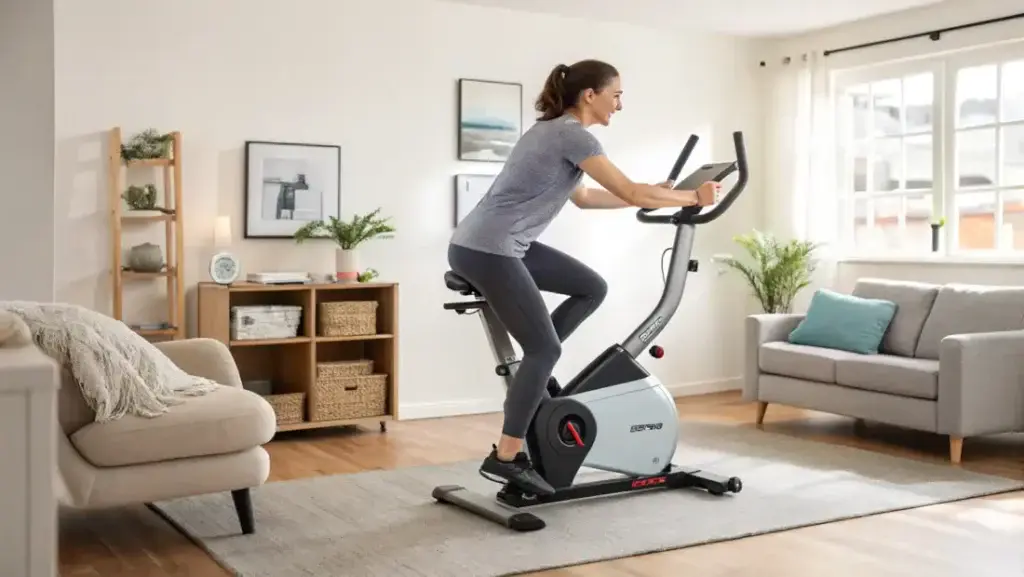
If you picture a standard stationary bike, you’re likely thinking of an upright model. It’s the quintessential home fitness staple for good reason.
A. What It Feels Like – The Classic Cycle Experience
Riding an upright bike closely resembles cycling on a traditional outdoor hybrid or commuter bike.
You’re seated in an upright (or slightly forward-leaning) posture, with the pedals positioned directly beneath your body.
B. Pros for Beginners (Specifically)
- Familiarity Factor: For many, this posture feels natural and intuitive, especially if you’ve ridden a bicycle before. This can reduce the initial learning curve.
- Core Engagement (Subtle but Present): Maintaining an upright posture requires more core stabilization compared to a recumbent bike, offering a gentle engagement of your abdominal and back muscles.
- Space Efficiency: Upright bikes generally have a smaller footprint than recumbent models, making them a good choice for homes where space is at a premium.
- Versatility for General Fitness: They are excellent for steady-state cardiovascular workouts and can accommodate moderate intensity levels, perfect for building foundational fitness.
C. Potential Cons for Beginners
- Saddle Soreness: The traditional bicycle-style saddle can be a source of discomfort for newcomers, especially during the first few weeks. Beginner Tip: Padded bike shorts or a gel seat cover can make a world of difference here!
- Potential for Wrist/Lower Back Strain: If your posture isn’t quite right, or if you have pre-existing weakness, the slightly forward lean can sometimes lead to minor strain in the wrists or lower back. Proper setup is key.
D. Is an Upright Bike the Best Exercise Bike for Your Beginner Needs?
- Consider it a strong contender if: You appreciate a traditional cycling feel, have limited space, don’t have significant pre-existing back or joint issues, and are looking for a solid, all-around tool for general fitness and moderate cardio.
- You might want to explore other options if: Seat comfort is your absolute top priority from day one, or if you have known back problems that are aggravated by an upright posture.
The Recumbent Exercise Bike – The Throne of Comfort
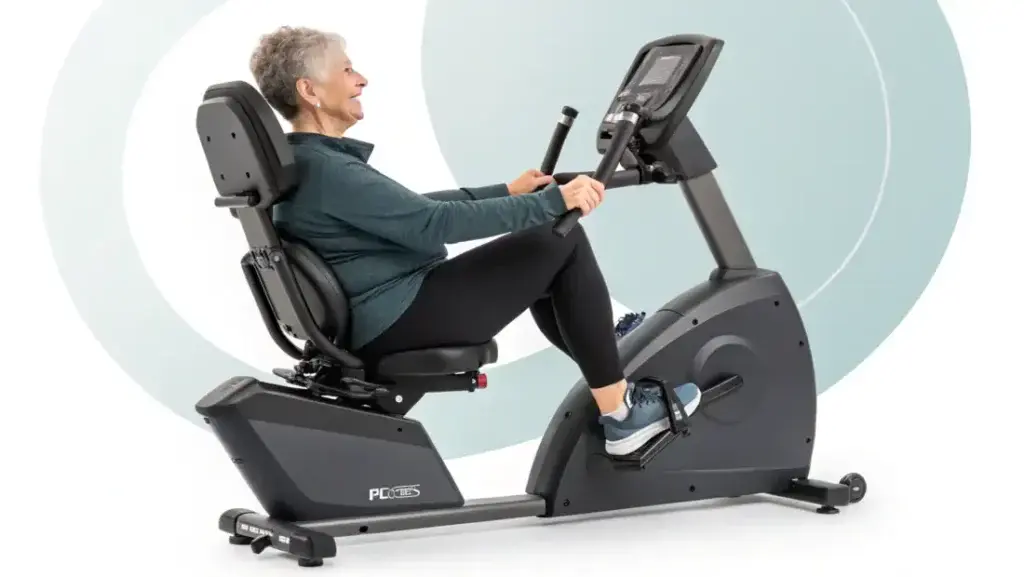
If the mere thought of a narrow bike saddle makes you wince, allow me to introduce the recumbent exercise bike – the undisputed champion of comfort in the stationary cycling world.
A. What It Feels Like – Laid-Back Pedaling Power
Imagine cycling from a comfortable chair. That’s the essence of a recumbent bike.
You sit in a larger, chair-like seat with full back support, and the pedals are positioned out in front of your body.
B. Pros for Beginners (Specifically)
- Unbeatable Comfort: This is the recumbent’s superpower. The wide, cushioned seat and supportive backrest make for an exceptionally comfortable ride, even for extended sessions. This can be a game-changer for adherence, especially for beginners.
- Kindest to Joints & Back: The reclined posture and full back support take virtually all stress off your lower back, hips, and knees. This makes it an excellent choice for individuals with joint pain, arthritis, or back issues. Here is an article COMPARISON OF TRUNK AND LOWER EXTREMITY MUSCLE ACTIVITY from The National Institutes of Health (NIH) (.gov).
- Ease of Access: The step-through design on many models makes getting on and off much easier than swinging a leg over an upright or spin bike, which is beneficial for those with mobility limitations.
- Reduces Fatigue: The enhanced support can help reduce overall body fatigue, potentially allowing beginners to work out for longer periods or more frequently.
C. Potential Cons for Beginners
- Less Core Engagement: Because your back is fully supported, your core muscles are less actively engaged compared to an upright bike.
- Different Feel: The pedaling motion is distinct from traditional cycling and might feel less “intense” or “athletic” to some individuals, even though the resistance can still be very challenging.
- Larger Footprint: Recumbent bikes tend to be longer and wider, requiring more dedicated floor space.
D. Is a Recumbent Bike the Best Exercise Bike for Your Beginner Needs?
- An enthusiastic “Yes!” if: Comfort is your non-negotiable top priority, you have existing back, knee, or hip concerns, you are significantly overweight, or you simply want the gentlest, most supportive introduction to cardiovascular exercise.
- Perhaps look at other types if: You are craving a more “athletic” or traditional cycling experience, maximizing core engagement is a key goal for you, or your available workout space is very limited.
My own mother, who has struggled with lower back pain for years, finally found her fitness groove with a recumbent bike. She says, “It’s the only way I can get my cardio in without paying for it the next day!”
The Spin Bike (Indoor Cycle) – The Performance-Focused Powerhouse
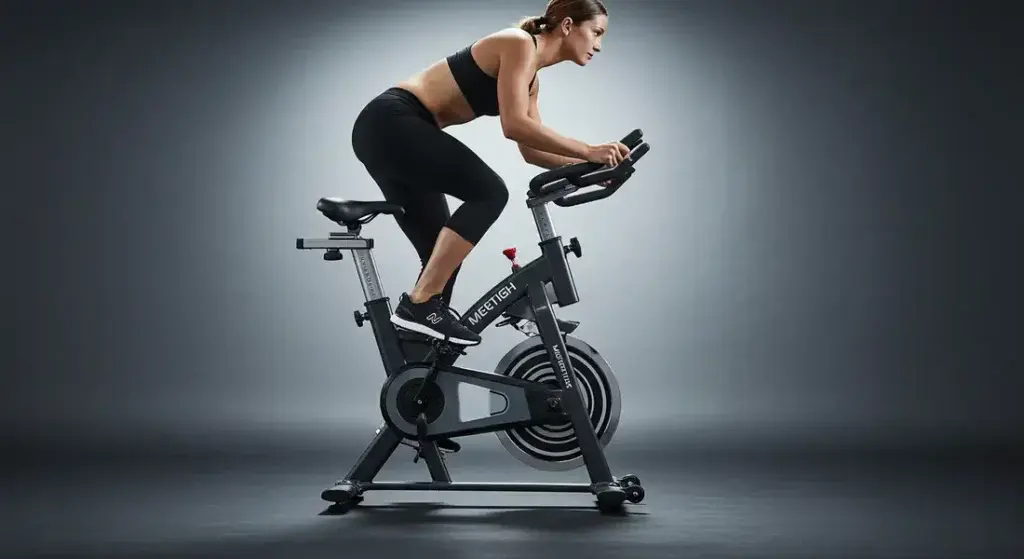
Often seen in high-energy studio classes, spin bikes (or indoor cycles) are designed to closely mimic the feel and performance of an outdoor road bike.
A. What It Feels Like – Bringing the Road (or Studio) Home
- Spin bikes typically feature a heavier flywheel, which contributes to a smoother, more continuous pedaling motion, especially at high RPMs.
- The geometry allows for a range of postures, from more upright to a very aggressive, forward-leaning road bike stance.
- They are built to handle standing climbs and high-intensity intervals.
B. Pros for Beginners (Specifically the “Ambitious” Kind)
- High-Intensity Potential: If you’re a beginner who’s ready to push your limits, a spin bike can certainly deliver the challenge.
- Road Bike Simulation: For those who aspire to outdoor cycling or enjoy the feel of a road bike, spin bikes offer the most realistic experience.
- Full Body Engagement (When Standing): Incorporating standing positions can engage more muscle groups, including the core and upper body, for stabilization.
- Durability: Spin bikes are generally built to withstand vigorous use and are often very robust.
C. Potential Cons for Most Beginners
- Less Initial Comfort: Spin bike saddles are often firmer and narrower, designed for performance rather than plush comfort. The more aggressive posture options can also be demanding for newcomers.
- Steeper Learning Curve for Form: Proper setup (seat height, fore/aft position, handlebar reach) is even more critical on a spin bike to ensure comfort, efficiency, and injury prevention. Getting this right can take a bit more trial and error.
- Can Feel Intimidating: The “serious cyclist” vibe and the intensity focus might be off-putting for true beginners who are just looking to get moving comfortably.
- Often Fewer “Creature Comforts”: Many spin bikes have simpler consoles, focusing on basic metrics like RPM and resistance, and may lack the pre-set workout programs or entertainment features found on some upright and recumbent models.
D. Is a Spin Bike the Best Exercise Bike for Your Beginner Needs?
- It could be a fantastic choice if: You’re an “ambitious” or “athletic” beginner, you’re motivated by high-intensity workouts, you specifically want to simulate outdoor road cycling, or you plan to follow online spin classes.
- It’s likely not the best starting point if: You are a true beginner prioritizing comfort and ease of use, you have significant joint or back issues, or you prefer a more relaxed, entertainment-focused workout experience.
Head-to-Head Comparison Table – Which Bike Ticks Your Beginner Boxes?
Let’s simplify this with a direct comparison:
| Feature/Consideration | Upright Bike | Recumbent Bike | Spin Bike (Indoor Cycle) |
| Overall Comfort | Moderate | Highest | Varies (Performance-focused) |
| Joint/Back Friendliness | Good | Excellent | Moderate (Form dependent) |
| Ease of Use (Beginner) | Very Good | Easiest | Good (Requires more setup care) |
| Core Engagement | Moderate | Low | Moderate to High (Form dependent) |
| Intensity Potential | Low to Moderate | Low to Moderate | Low to Very High |
| Space Required | Smallest | Largest | Moderate |
| “Road Feel” Simulation | Low | Very Low | Highest |
| Typical Price Range | −−$ | −−$ | −− |
| Best For Beginner Type | General, Returning | True Beginner, Comfort-Seeker | Ambitious, Athletic |
Key Deciding Factors Simplified – Your Personal “Best Bike” Checklist
Feeling a bit clearer? Let’s boil it down to a quick checklist:
- Your Primary Goal is Paramount:
- General Fitness & Weight Management: Upright or Recumbent.
- Maximum Comfort, Rehab, or a Very Gentle Start: Recumbent is likely your winner.
- High-Intensity Training, Performance Focus, Outdoor Cycling Prep: Spin Bike.
- Listen to Your Body (Comfort & Existing Conditions):
- This is non-negotiable. No exercise bike is “good” if it causes you pain or aggravates an existing condition. Recumbent bikes generally lead the pack for accommodating physical limitations.
- Consider Your Workout Space:
- Measure the area where you plan to put your bike. Uprights are typically the most compact, followed by spin bikes, with recumbents usually requiring the most room.
- Factor in Your Budget:
- You can find good quality beginner-friendly bikes in all three categories, but prices can vary significantly. Set a realistic budget before you start shopping.
- The “Enjoyment Factor” Matters More Than You Think:
- Which bike type genuinely appeals to you the most? The one you’re excited (or at least willing) to use regularly is the one that will deliver results.
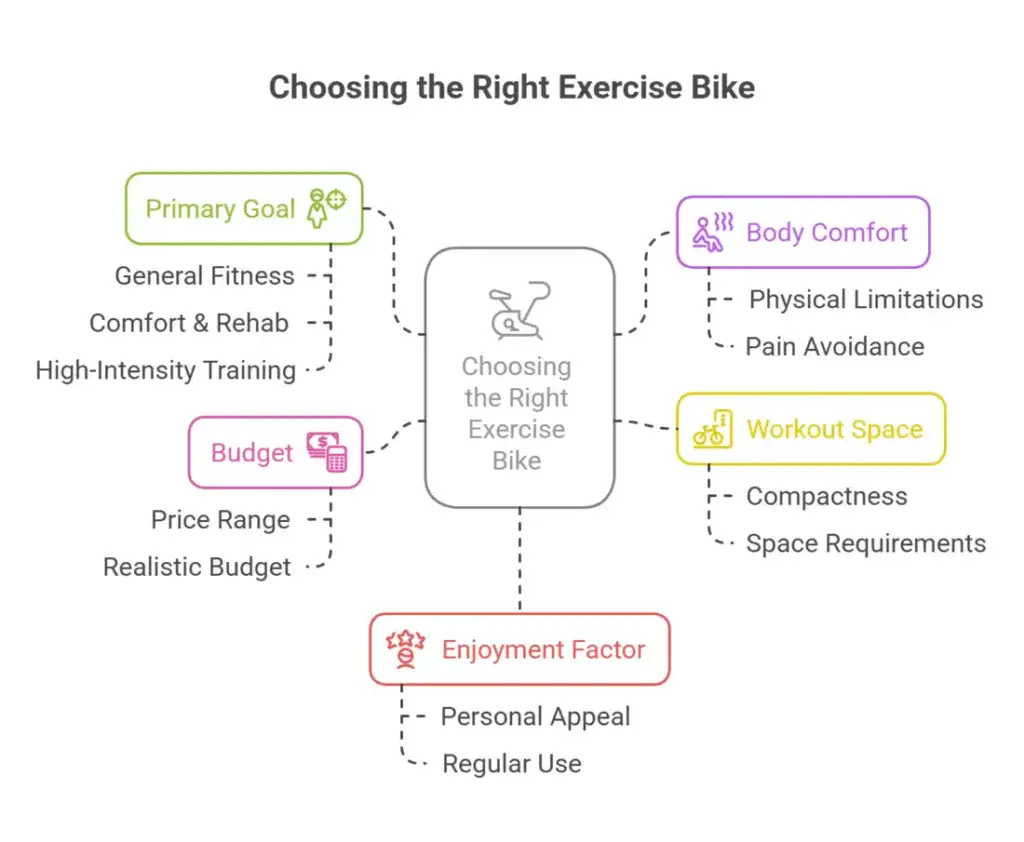
Don’t Forget These Universal Beginner Considerations (Regardless of Type)
No matter which type of bike you lean towards, certain features are universally important for a good beginner experience:
- Adjustability is King: Ensure the bike offers ample adjustment for seat height, horizontal seat position (fore/aft), and handlebar position (where applicable). Proper fit is crucial for comfort and effectiveness.
- Smooth & Reliable Resistance: You want a resistance system that is easy to adjust and provides a consistent challenge. Magnetic resistance is often preferred for its quiet and smooth operation.
- Clear & Simple Console: As a beginner, focus on a console that clearly displays essential metrics: time, speed, distance, and estimated calories burned. Don’t get bogged down by overly complex interfaces initially.
- For a deeper dive, see our guide on Essential Exercise Bike Features All Beginners Need.
Frequently Asked Questions (FAQs) for Choosing Your First Bike Type
- Q1: I’m very overweight. Which exercise bike is best for me as a beginner?
- A: A recumbent bike is frequently the top recommendation. Its large, supportive seat, full backrest, and often easier step-through access provide maximum comfort and stability. Always verify the bike’s maximum user weight capacity before purchasing.
- Q2: I want to lose weight fast. Should I just get a spin bike because it’s more intense?
- A: While spin bikes can facilitate high-intensity, calorie-burning workouts, consistency is far more important for sustainable weight loss, especially for beginners. If a spin bike feels too uncomfortable or intense initially, you might be less likely to use it regularly. An upright or recumbent bike that you use consistently will likely yield better long-term results. Any of these bike types can contribute effectively to weight loss when paired with a suitable diet.
- Q3: Can I still get a “good enough” workout on a recumbent bike if it’s so comfortable?
- A: Absolutely! “Good enough” is subjective, but a recumbent bike can provide an excellent cardiovascular workout. They offer a wide range of resistance levels that can challenge beginners and even more advanced users. Don’t mistake comfort for lack of effectiveness!
- Q4: Are there “hybrid” exercise bikes that combine features of different types?
- A: Some bikes on the market do try to blend features, like “dual-action” bikes with moving handlebars for an upper-body component, or some uprights with slightly larger seats. However, for true beginners trying to make a clear choice, focusing on one of the three primary, distinct categories (Upright, Recumbent, Spin) often simplifies the decision-making process and ensures the bike excels at its core design purpose.
Conclusion – Making Your Choice and Moving Forward with Confidence
Choosing between an Upright, Recumbent, and Spin bike isn’t about finding the one “perfect” bike – it’s about finding the one that’s perfect for you and your current stage in your fitness journey.
By considering your personal beginner profile, your comfort needs, your fitness goals, and the practicalities of your space and budget, you’re now well-equipped to make an informed decision.
Remember, the ultimate goal is to select an exercise bike that you’ll not only use but also enjoy using.
That’s the real secret to building a sustainable home fitness habit.
So, which bike type is calling your name? Or do you still have questions? Share your thoughts – we’re here to help!
Ready to take the next step on your beginner journey?
- Explore detailed reviews and our top picks: Best Exercise Bikes for Beginners (Sorted by Type!).
- Don’t forget to check the must-have features: Essential Exercise Bike Features All Beginners Need.
- Need a broader refresher? Head back to our Ultimate Beginner’s Guide to Choosing and Using an Exercise Bike at Home.
Happy pedaling!
